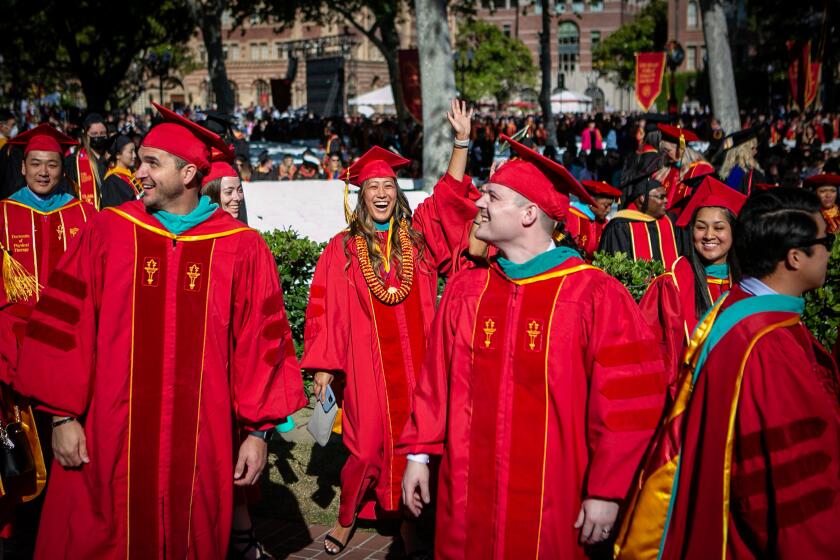Federal student loan collections restart. Here’s what you need to know

- Share via
- For the first time in five years, the federal government is resuming collections on federal student loans that are in default, starting May 5.
- Students with outstanding loans have several options for paying off or paying down the debt.
- More than 5 million borrowers are in default, meaning they haven’t make a payment in 270 days.
For the first time in five years, starting this week, the federal government is resuming collections on federal student loans that are in default, an accelerated process that allows financial institutions to begin collecting funds from a borrower’s wages, tax refunds or Social Security benefits.
“Going forward, the Department of Education, in conjunction with the Department of Treasury, will shepherd the student loan program responsibly and according to the law, which means helping borrowers return to repayment — both for the sake of their own financial health and our nation’s economic outlook,” Education Secretary Linda McMahon, said in a statement.
The collections of federal student loans were paused during President Trump’s first term as a temporary relief measure in response to the COVID-19 pandemic. The Biden administration extended that pause several times until payments were resumed in October 2023, but repayment rules were relaxed and borrowers had a 12-month grace period without being penalized until last fall.
Toward the end of 2024, some Biden-era income-driven repayment plans, including Saving on a Valuable Education, remained in legal limbo or blocked from implementation because of a federal court ruling that left millions of borrowers awaiting a resolution.
Now, more than 5 million borrowers are in default, including some who went into default before the pandemic. A borrower is in default if they haven’t made a payment in 270 days.
An estimated 4 million more borrowers are in late-stage delinquency, meaning a payment hasn’t been made in more than 90 days, and are quickly headed toward default, according to the Department of Education.
The moratorium was slated to expire Jan. 1, a date Biden set before his plan stalled in the face of legal challenges from conservative opponents.
My loan is in default, what happens next?
On Monday, the office of Federal Student Aid restarted the Treasury Offset Program, a debt collection tool that allows the government to collect income tax refunds and other federal payments to put toward paying off the loans. The government can also withhold recurring payments such as Social Security benefits starting in June.
Over the next two weeks, all student loan borrowers in default will receive an email from the office notifying them about the Treasury Offset Program and their student loan status.
This summer, the office will order the employers of borrowers to withhold a portion of the employee’s income to pay off the loans. It is known as a notice of administrative wage garnishment.
Borrowers in default should contact the Default Resolution Group for assistance in making a monthly payment, enrolling in an income-driven repayment plan, or signing up for loan rehabilitation. The wage garnishment will continue until students get the loans out of default.
How can I check the status of my loan?
Borrowers can check the status of their loans, including outstanding loan balances and servicer information by logging on to their online Federal Student Aid account. The loan servicer is the company the office of Federal Student Aid assigns to handle the billing and other services of the loan.
Specific loan servicer information can be found on the account dashboard under “My Loan Servicers.” For more information about a borrower’s loan servicer, students should call the Federal Student Aid Information Center at (800) 433-3243 and be prepared to provide personal information connected to the loan account.
If a borrower is delinquent and in danger of heading toward default, loan servicers will send multiple notices via email, mail or phone call. The online Federal Student Aid account enables borrowers to ensure their contact information is up to date so that they don’t miss a notification.
President Trump is ordering changes to the Public Service Loan Forgiveness program that would disqualify workers of nonprofit groups deemed to have engaged in ‘improper’ activities.
My loan is in default. What can I do about it?
There are three ways a borrower can get their loan out of default:
- Pay the loan in full.
- Rehabilitate the loan.
- Consolidate the loan.
To rehabilitate a defaulted loan, a borrower must make nine on-time monthly payments in an amount that’s typically based on their income. That is done in an arrangement with the company that manages their loan.
What happens once the nine payments are made:
- The defaulted loan will no longer be in default.
- The record of the default on the rehabilitated loan will be removed from the borrower’s credit history. What will show up on the credit history is the late payments that were reported by the loan holder before the loan went into default.
- Any offsets or wage garnishment launched on a borrower’s loan will stop.
Consolidating a defaulted loan allows a borrower to pay off one or more federal student loans with a new direct consolidation loan. The process is managed by the Department of Education’s Default Resolution Group.
Before paying off the debt through a consolidation loan, a borrower must either agree to repay the new direct consolidation loan under an income-driven repayment plan or make three consecutive on-time, voluntary full monthly payments on the defaulted loan.
Borrowers should note that their accrued interest gets added to the principal balance of the consolidated loan. The borrower is responsible for future interest on a higher balance, which can lead to an overall higher monthly payment.
If a loan servicer is collecting payments on a borrower’s defaulted loan through wage garnishment, the borrower cannot consolidate the loan until the wage garnishment order has been lifted.
What happens after consolidation:
- The record of default and the late payments before default will remain on a student’s credit history.
- Late payments will remain in a student’s history for seven years.
- The consolidated loan will be eligible for deferment, forbearance and loan forgiveness.
More to Read
Sign up for Essential California
The most important California stories and recommendations in your inbox every morning.
You may occasionally receive promotional content from the Los Angeles Times.













